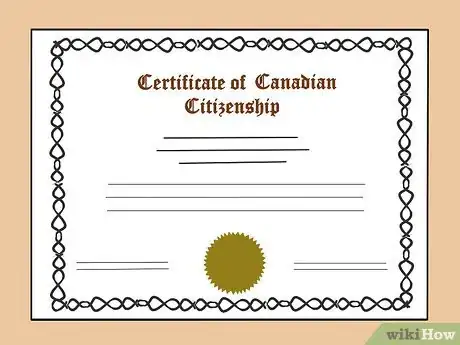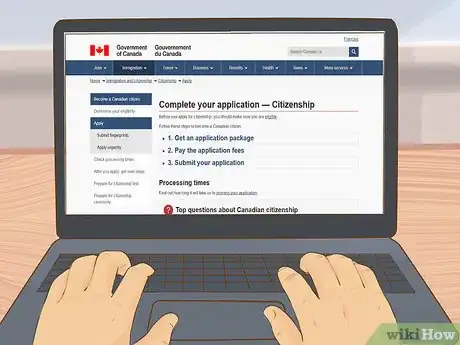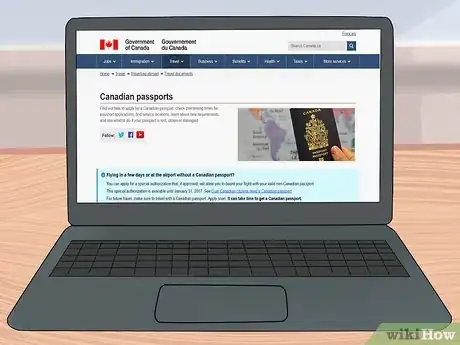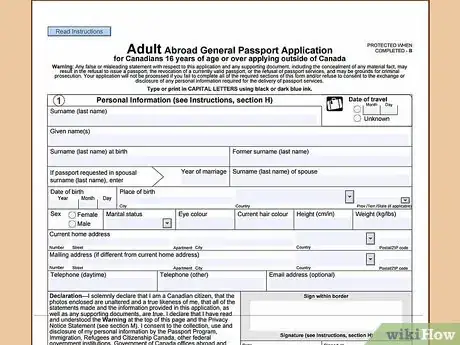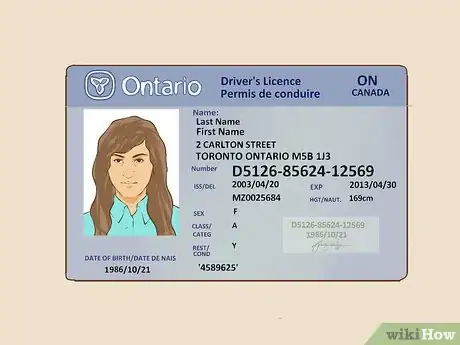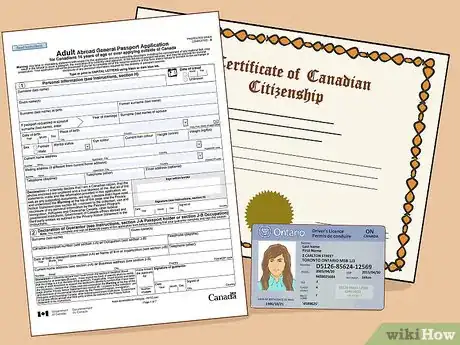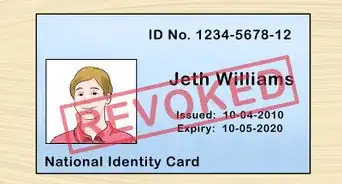This article was co-authored by Timothy Morson. Timothy Morson is a Canadian Immigration Specialist and a former Canadian Diplomat. With over 30 years of experience, Timothy specializes in Canadian immigration programs, immigration management, employer compliance, and international mobility. He holds a BA in Political Science from Concordia University and an MA in Journalism from Western University. Timothy is accredited by the Immigration Consultants of Canada Regulatory Council (ICCRC), Immigration Quebec, and is a member of the Order of Chartered Administrators of Quebec (Adm.A). He works to help people and companies around the world achieve their immigration goals.
There are 20 references cited in this article, which can be found at the bottom of the page.
This article has been viewed 70,667 times.
A Canadian passport proves your identity and citizenship, and you need one if you wish to travel abroad. To apply for a passport, you must provide proof of citizenship, a supporting document to confirm your identity, two passport photographs, a monetary fee, and a completed application form. In addition, you’ll need two non-family references and a guarantor to sign off on your application. Given all that’s involved in the application process, make sure you submit your application at least 2 months in advance of any travel plans.
Steps
Establishing Canadian Citizenship
-
1Establish your citizenship if you were born in Canada. You’ll need to submit an original document (no copies) that proves your citizenship. If you were born in Canada, you are most likely a Canadian citizen. You can either use your Certificate of Canadian Citizenship or the birth certificate issued by the province or territory where you were born.[1]
- If you need a copy of your birth certificate, contact the vital statistics office of the province or territory where you were born.[2]
-
2Verify your citizenship if you were born outside of Canada. If your parents are Canadian citizens, and you were born outside of Canada, you are likely a Canadian citizen. You can use your certificate of Canadian citizenship, certificate of naturalization, registration or birth abroad, or retention of Canadian citizenship.[3]
- You can contact Passport Canada, which is the government agency that processes applications, if you believe you're a citizen but need to apply for a citizenship certificate.[4]
Advertisement -
3Consult Passport Canada with further questions about your citizenship. If you have specific questions about your citizenship status, Passport Canada offers a variety of easy tools to assist you. If you're not sure whether or not you're a citizen, consult their help guide to determine your status.[5]
- If you were born in Canada to foreign diplomats or officials, your citizenship was revoked, or you renounced your citizenship, you are most likely not a Canadian citizen and would need to reapply if you are eligible.
- In general, if you've married a Canadian citizen, were adopted by Canadian parents, or lived in Canada as a permanent resident, you are not automatically a Canadian citizen. You must apply to become a citizen using this application: http://www.cic.gc.ca/english/citizenship/become-how.asp
- If you need to apply for citizenship, check out the Passport Canada eligibility guide to see if you qualify: http://www.cic.gc.ca/english/citizenship/become-eligibility.asp
Completing Your Application
-
1Visit Passport Canada’s website. To apply for a passport, you will need to consult the website of Passport Canada. You can find eligibility restrictions, all required forms, and descriptions of everything you’ll need to provide with your application. The site also offers checklists and explanations of what’s required for various types of passports, such as instructions on children’s passport applications and how to apply if you live in a country other than Canada.
- Consider if any prohibitions that might restrict you from getting a passport. If you have a past criminal conviction, are incarcerated, or have any pending cases on your record, you might have difficulty obtaining a passport, depending on the severity and nature of your circumstances.[6]
- A criminal record or even being named in a police report can also complicate your passage into another country. If you have travel plans and have any concerns, contact the border patrol or customs agency of your prospective destination.[7]
-
2Access and fill out the appropriate application form. You’ll find all forms you’ll need on Passport Canada’s website. If you are 16 years or older and live in Canada, you’ll need form PPTC 153.[8] If you are under the age of 16, you need form PPTC 155, which your parent or legal guardian will need to submit for you.[9]
- Use form PPTC 040 if you’re a Canadian citizen but reside in another country.[10] Find your local Canadian embassy or consulate for assistance in obtaining a passport or any required documents.[11]
- Fill out all applicable forms in their entirety, and take care to follow their instructions.
- Have your required documents on hand when filling out your application. You’ll be writing your citizenship certificate and identification numbers on the form.
-
3Find a guarantor and two references. A guarantor must fill out and sign a section of your application, certify that your passport photographs are actually pictures of you, and sign and date any identification document copies you submit. You’ll also include the names of two references who have known you for at least two years and agree to the possibility of being contacted to confirm your identity.[12] [13]
- A guarantor must be 18 years or older, a Canadian citizen, and hold a valid passport or one that expired less than a year prior to the application date. Your guarantor can be a family member.
- Your references must be 18 years or older, cannot be your guarantor, and cannot be a family member or spouse's family member. Your references need not be Canadian citizens.[14]
- If you cannot find a guarantor, visit your local passport service location to fill out PPTC form 077, which must be obtained in person.[15]
-
4Submit at least one document that confirms your identity.[16] Your identification document must be currently valid and government-issued. It must include your name, sex, date of birth, photograph, and signature. If you don’t have one document that meets these requirements, you can submit multiple items that include all necessary information in combination.[17]
- Examples include your driver's license, non-driver's identification card, military identification, or government employee identification card.
- You can submit original documents or photocopies of your identification confirmation. If you send originals, they will be returned to you after your application is processed.
- If you send photocopies, be sure to copy both sides of the document. You’ll need to have your guarantor sign and date each side’s copy.
-
5Include two identical passport photographs. Visit a photography studio or hire a commercial photographer to take your passport pictures. On their reverse sides, the photographs must include the name and address of the studio or photographer, as well as the date it was taken. In addition, the photographs must:[18]
- Clearly show your face with a neutral expression (no smiling), with uniform lighting.
- Conform to specific sizing and placement standards.
- Be printed on photographic paper that is 2 inches (5.1 cm) wide by 2-3/4 inches high.
Submitting Your Application
-
1Make sure your application is complete. Double check to be certain you don’t need to include any additional information, such as verification of a name change or declaration form if you’re replacing a lost or stolen passport. If you are replacing a valid Canadian passport or have other valid travel documents on hand, enclose them with your application.[19]
- You do not need to submit expired travel documents with a new passport application.
- If your legal name is no longer the same as that listed on your citizenship or birth certificate, find the appropriate form on Passport Canada’s website.[20]
- Be sure that all of your forms are completed as instructed. An incomplete form, non-compliant photo, or improperly submitted identification documents will result in rejection, and you’ll lose your non-refundable application fee.
-
2Pay the application fee. The fee is subject to change, and depends on whether you’re applying for an adult or child passport, your country of residence, and the length of time your passport will be valid. Use Passport Canada’s fee guide to check the current fee for your specific needs.[21]
- You can pay with Visa, Mastercard, or American Express credit card, a debit card, or certified check or money order.
- There is a section on your application form where you can input credit or debit card information.
- Make checks or money orders out to “Receiver General for Canada.”
-
3Submit your application by mail. If you opt to send your application through the mail, Passport Canada recommends using service that enables you to trace it, since you are sending valuable personal information and original documents. .
- To send your application by mail, address it to:: Government of Canada, Passport program, Gatineau, Quebec K1A 0G3.
- If you are sending your application by courier, send it to Government of Canada, Passport program, 22 de Varennes Street, Gatineau, Quebec J8T 8R1.
-
4Submit your application in person. Alternatively, you can visit a Passport Canada regional office, a participating Service Canada Center, or a participating Canada Post Office. You must submit your application in person for urgent or express service. To locate the nearest passport service location, you can use Passport Canada’s online search tool.[22]
- In general, new passports and other travel documents are mailed to you. You can also pay an extra fee to pick your passport up in person at your local participating passport service location as soon as it’s available.
Expert Q&A
Did you know you can get expert answers for this article?
Unlock expert answers by supporting wikiHow
-
QuestionHow do I apply for a new passport if my current one is damaged?
 Timothy MorsonTimothy Morson is a Canadian Immigration Specialist and a former Canadian Diplomat. With over 30 years of experience, Timothy specializes in Canadian immigration programs, immigration management, employer compliance, and international mobility. He holds a BA in Political Science from Concordia University and an MA in Journalism from Western University. Timothy is accredited by the Immigration Consultants of Canada Regulatory Council (ICCRC), Immigration Quebec, and is a member of the Order of Chartered Administrators of Quebec (Adm.A). He works to help people and companies around the world achieve their immigration goals.
Timothy MorsonTimothy Morson is a Canadian Immigration Specialist and a former Canadian Diplomat. With over 30 years of experience, Timothy specializes in Canadian immigration programs, immigration management, employer compliance, and international mobility. He holds a BA in Political Science from Concordia University and an MA in Journalism from Western University. Timothy is accredited by the Immigration Consultants of Canada Regulatory Council (ICCRC), Immigration Quebec, and is a member of the Order of Chartered Administrators of Quebec (Adm.A). He works to help people and companies around the world achieve their immigration goals.
Canadian Immigration Specialist
-
QuestionHow do I renew a passport?
 Timothy MorsonTimothy Morson is a Canadian Immigration Specialist and a former Canadian Diplomat. With over 30 years of experience, Timothy specializes in Canadian immigration programs, immigration management, employer compliance, and international mobility. He holds a BA in Political Science from Concordia University and an MA in Journalism from Western University. Timothy is accredited by the Immigration Consultants of Canada Regulatory Council (ICCRC), Immigration Quebec, and is a member of the Order of Chartered Administrators of Quebec (Adm.A). He works to help people and companies around the world achieve their immigration goals.
Timothy MorsonTimothy Morson is a Canadian Immigration Specialist and a former Canadian Diplomat. With over 30 years of experience, Timothy specializes in Canadian immigration programs, immigration management, employer compliance, and international mobility. He holds a BA in Political Science from Concordia University and an MA in Journalism from Western University. Timothy is accredited by the Immigration Consultants of Canada Regulatory Council (ICCRC), Immigration Quebec, and is a member of the Order of Chartered Administrators of Quebec (Adm.A). He works to help people and companies around the world achieve their immigration goals.
Canadian Immigration Specialist
References
- ↑ http://www.cic.gc.ca/english/citizenship/proof.asp
- ↑ http://www.servicecanada.gc.ca/eng/subjects/cards/birth_certificate.shtml
- ↑ http://www.cic.gc.ca/english/passport/apply/citizenship-proof.asp
- ↑ http://www.cic.gc.ca/english/citizenship/proof-how.asp
- ↑ http://www.cic.gc.ca/english/citizenship/rules/index.asp
- ↑ http://www.cba.org/cba/cle/pdf/Green.pdf
- ↑ http://www.lawnow.org/criminal-records-police-reports-can-ruin-travel-plans/
- ↑ http://www.cic.gc.ca/english/passport/forms/pdf/PPTC153.pdf
- ↑ http://www.cic.gc.ca/english/passport/forms/pdf/pptc155.pdf
- ↑ http://www.cic.gc.ca/english/passport/forms/pdf/PPTC040.pdf
- ↑ https://travel.gc.ca/assistance/embassies-consulates?_ga=1.181360935.1452945496.1477540092
- ↑ http://www.cic.gc.ca/english/passport/apply/guarantor-reference.asp
- ↑ Timothy Morson. Canadian Immigration Specialist. Expert Interview. 26 January 2021.
- ↑ http://www.canadavisa.com/canada-immigration-discussion-board/applying-for-passport-who-can-be-a-reference-t383835.0.html
- ↑ http://www.cic.gc.ca/english/passport/map/map.asp
- ↑ Timothy Morson. Canadian Immigration Specialist. Expert Interview. 26 January 2021.
- ↑ http://www.cic.gc.ca/english/passport/apply/documents-identity.asp
- ↑ http://www.cic.gc.ca/english/passport/apply/photos.asp
- ↑ http://www.cic.gc.ca/english/passport/apply/new/apply-how.asp
- ↑ http://www.cic.gc.ca/english/passport/apply/name-change.asp
- ↑ http://www.cic.gc.ca/english/passport/fees/index.asp
- ↑ http://www.cic.gc.ca/english/passport/map/map.asp
About This Article
To get a Canadian passport, start by visiting the Passport Canada website and accessing the application form. Then, fill out the form and have a guarantor sign it to affirm that you’re who you say you are. Make sure your guarantor is 18 or older, is a Canadian citizen, and has a valid passport. You should also include a copy of your drivers’ license or I.D. card, two passport photos, and proof of citizenship. Finally, submit your application along with the application fee through the mail or at a Passport Canada office. For advice on how to prove your citizenship for a passport if you don’t have a Canadian birth certificate, read on!
